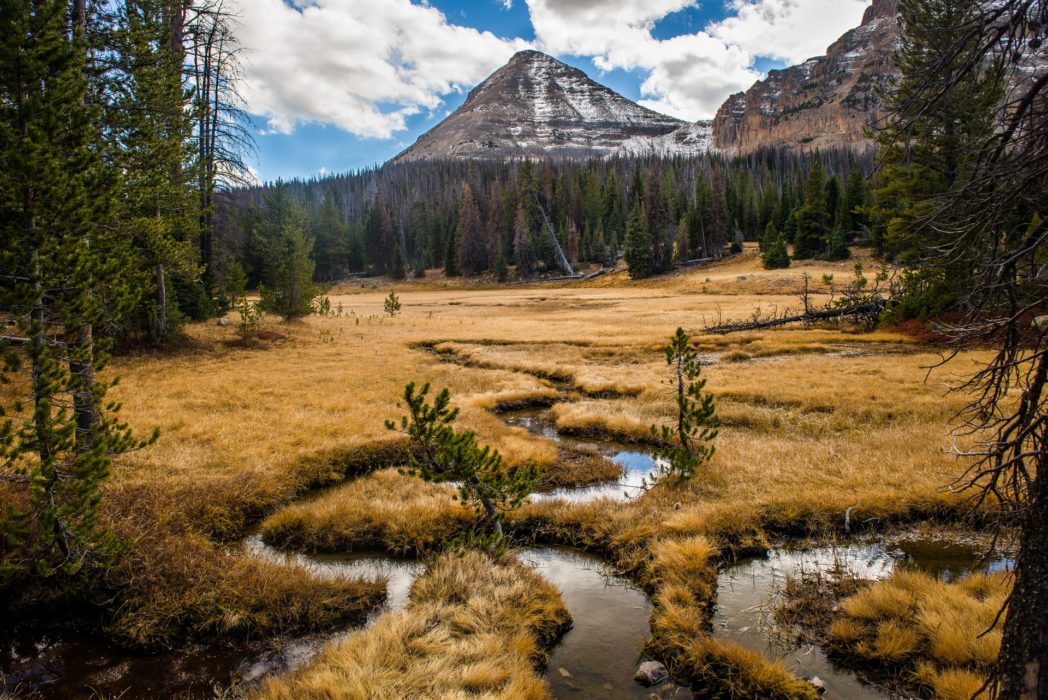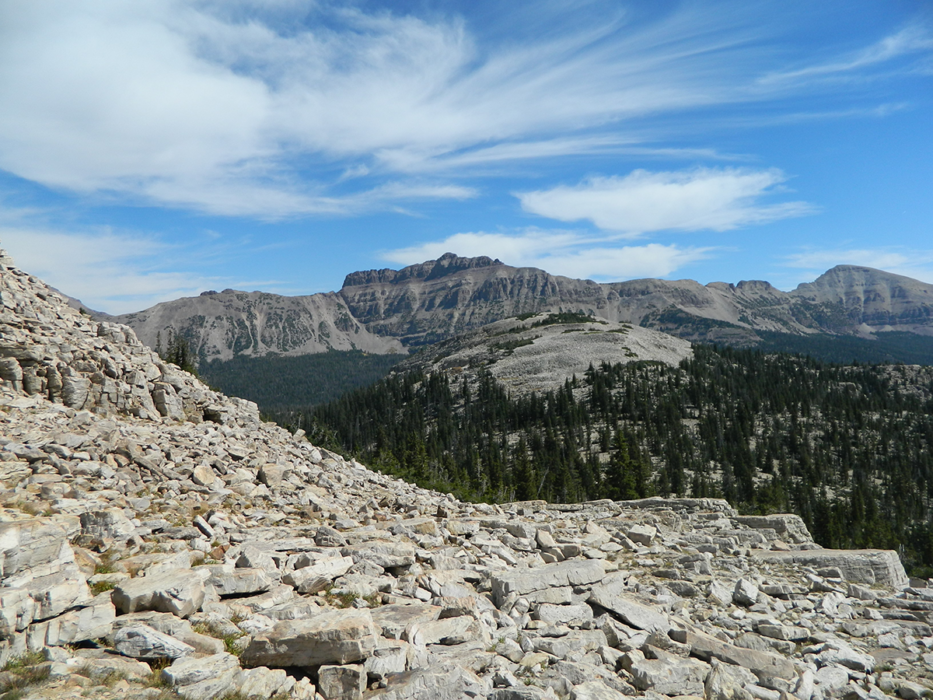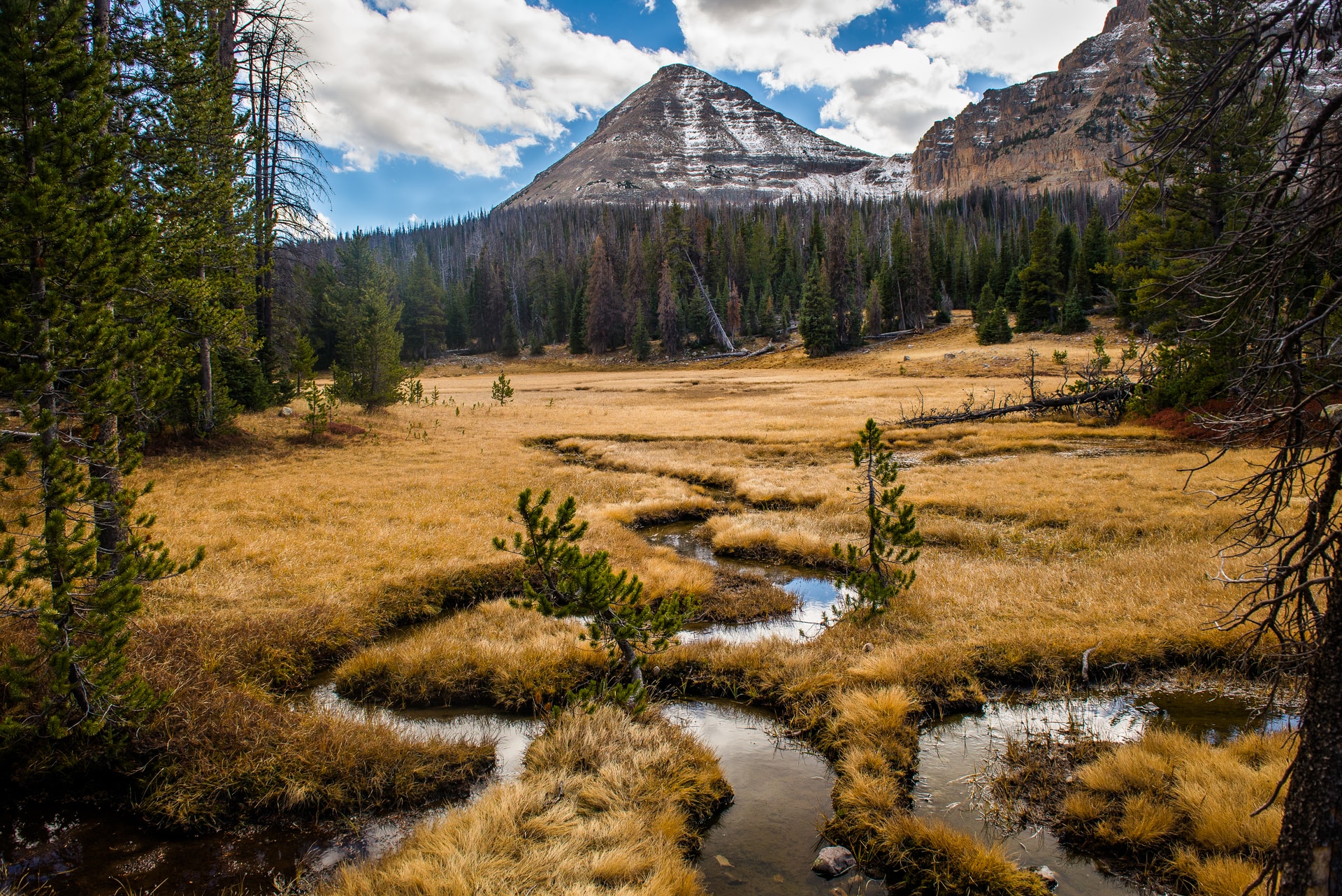
Mountain View, Wyoming, got its name for an obvious reason. Most of the Uinta Mountains are visible from town, but two 13,000-foot peaks — Gilbert and Kings — are the most prominent. Gilbert looms like a quartzite pyramid due south of the ag-and-mining town of 2,000 people; Kings, tallest in the Uintas, is tucked just behind.
I grew up in Mountain View, and saw these peaks almost every day I was there: from the highway leading into town, framed by the goalposts on our high school’s football field, driving to the mountains to camp in the summer. But I never saw them up close until 2009, the year I graduated from high school. That year, I hiked to Painter Basin, at the foot of Kings Peak. It’s one of those remarkable alpine meadows where wildflowers cram their beauty into short summers and the weather reminds you — with quick downpours and thunder so loud it seems to boom from behind rather than above — that it’s in charge up here.
I haven’t returned to Painter Basin, but I think of it often. I moved away from Wyoming later that year, and since then, I’ve been reexamining my relationship with the place where I grew up. As with all young people, my plans for the future shifted as I went through school, but there was one constant: leave. Getting out wasn’t so much a marker of success as a prerequisite for it. Dynamics unique to myself and my family were at play when I decided to skip town, but I realize now they were shaped on a cultural backdrop that glorifies mobility. We Westerners like to move around, always have. And I’ve come to believe that’s not such a good thing.
This story first appeared in the Bitterroot Newsletter. Sign up below to receive Jake’s latest writing in your inbox.
For thousands of years, Western Americans moved out of necessity. Native Americans migrated to the places where resources were most available during the particular season, and to trade or raid for resources they lacked. The earliest European settlers found themselves covering long distances to prospect, trap, hunt, or get to Oregon ASAP. “Mobility,” Wallace Stegner wrote in a 1987 essay, “was the condition of life beyond the Missouri.”
Stegner credits the early mobility to the West’s aridity (that essay is titled “Living Dry”). But Western movement has lately been driven by money and perceived opportunity. First there were the famous rushes — of gold, of timber, of free land. But this trend hasn’t abated at all. Now, Americans flock to and around the West in a rush for tech jobs, oil booms, outdoor amenities, “Zoom towns”— all commodities that today are as alluring as those 1850s gold nuggets. All the shuttling leaves us with cities and towns populated by folks who know little about the place where they live, let alone have a connection with its history.
“Migrants deprive themselves of the physical and spiritual bonds that develop within a place and a society,” Stegner wrote. He went on:
“Our migratoriness has hindered us from becoming a people of communities and traditions, especially in the West. It has robbed us of the gods who make places holy. It has cut off individuals and families and communities from memory and the continuum of time. … Especially in the West, what we have instead of place is space. Place is more than half memory, shared memory. Rarely do Westerners stay long enough at one stop to share much of anything.”
Three decades later, Stegner’s criticism holds up. The condition he described gives our cities a collective amnesia about what is normal in our home regions. The half-million residents Denver added in the last decade can’t compare this year’s wildfire season with the milder conditions of decades past. To the 800,000 new Phoenix residents, heat death is just part of living here, 110-degree temps the norm. The 600,000 folks who moved to the Seattle-Tacoma area in the last decade probably aren’t alarmed that the local sockeye salmon run is nearing extinction; they — myself included — weren’t around in 2006, when there were enough salmon to support a commercial fishing season right near downtown Seattle. And none of us remember a time when we could easily afford to live in any of these places.
My own thinking about mobility really began to shift after a conversation I had with Ellie Kinley, the head of a fishing family and a staffer for the Lummi Nation’s Sovereignty and Treaty Protection Office. A couple years ago, I drove up to the Lummi reservation in northwest Washington to chat with her about the tribe’s efforts to save our local orcas, which — like the salmon they eat — are at risk of dying out.
Much of our conversation, though, gravitated around the concept of home. Kinley is no homebody — fishing has taken her from the Bay Area up to Alaska. But she’s maintained a connection with Lummi and the tribe’s traditional fishing waters that still leaves me envious. The waters around the San Juan Islands are particularly special to Kinley. She told me about fishing there with her father when she was a young girl. “Nobody had to tell me this was our home, that our ancestors are here,” she said. “I just knew. I could feel it.”
Toward the end of our conversation, Kinley turned the question on me: “You asked us how we feel when we go out to the islands. Can I ask you — do you ever do anything, or been anywhere, that so completely fills your heart that you know you’re in the right spot, at the right time? That you’re supposed to be where you’re at?”
Listening to the recording of our conversation is brutal. My insecurities poured out. “There are absolutely times where I’m out and about, where I say I feel something close to that, where it feels like what’s around me is in a nice harmony, like things kinda make sense with where they are,” I said. “That could be me alone out in the woods, or that could be me sitting in a special place with family members.”
What a bunch of bullshit. I finally cut to the chase: “I can’t say that I’ve had that place that’s like, this is home, the way you all describe. There are places that are special to me, but, I mean, I’ve moved around. So I don’t think I can, in honest conscience, say that that feeling of home has manifested itself. Because if it had, I’d be there.”
Kinley is a rooted Westerner. I’m Stegner’s migrant.
I suppose it’s time to examine where I’ve lived, and why I moved. Mountain View is, I now more keenly realize, a stunning place. The Smith’s Fork of the Green River flows right through town; as a kid, I spent countless hours tromping in and around the river, chasing critters real and imagined through tunnels in the willow thickets on its banks. It wasn’t uncommon to see moose and deer in our backyard. Sunset in the badlands outside of town is about as pretty as any you’ll find in the West. And did I mention the Uintas?
Despite these natural treasures and a mostly carefree and easy youth, I never had the notion of sticking around. My household was definitely what the anthropologist Margaret Mead has called a “launching pad.” I didn’t know where my destination was, but it certainly was somewhere else. Oregon. Colorado. Utah. It didn’t matter. My parents wanted my brother and me to try a new place, and neither of us considered otherwise.
With college began a journey in which I have moved damn near as much as a roughneck. First up: Salt Lake City, to study at the University of Utah. Those four years remain my longest stint in a single place as an adult. Salt Lake, honestly, might be the place to which I have the strongest attachment. The Wasatch, the adjacency to Mormonism, the weird politics, the skiing, the blissful shoulder seasons, a city on the rise; I cried the day my now-wife and I left.
From Salt Lake, we went to Washington, where my wife attended graduate school. Beginning in 2013, we lived in the Seattle suburbs of Burien and Renton, Whidbey Island (undeniably the most scenic place I’ve lived), then Renton again, before landing in Tacoma. “Being footloose has always exhilarated us,” Stegner wrote. No kidding.
The goal, now, is to remain in Tacoma and establish here the roots I’ve never had. But, even if I succeed in that regard (my history suggests that’s no guarantee), I wonder if my son will foster the same connection to Tacoma. Or if I’ll want him to; I don’t mind the idea of him ending up in Denver, Los Angeles, or Boise one bit. My household could become a launching pad, too.
When I think about the folks I grew up with who remain in Mountain View, many — if not most — of them had a stronger attachment to our town’s unique characteristics than I did. Mountain View is near some of the best hunting, all-terrain vehicle trails, and snowmobiling anywhere. My family participated in these activities, but my classmates who stuck around were obsessed with them. My family’s annual calendar was dictated by football and basketball, not weeklong elk hunts and spring snowmobiling. After I picked up skiing, I felt a stronger attachment to Utah’s resorts than the open spaces near Mountain View. That hike to Painter Basin? Aside from one other backpacking trip in college, it was my only outing into the high Uintas.
Not to say any of this is bad, or that I should’ve devoted my life to hunting or dirt bikes. The big reason my family is in Tacoma and not Mountain View, after all, is because we believe we’re happier here than we would be there. But there are drawbacks to the get-out logic. Stegner’s migrants feel little need to stick around, to improve the place they call home. If they don’t like something, they just leave — not exactly the hallmark of a good citizen.
If one wants to minimize the feeling of geographic aimlessness, it might help to adopt the philosophy of Ellie Kinley and some of my classmates. They are, by all means, footloose — leisure and work takes them around the country. But their connection to the geography of home keeps them rooted — even as they wander, as Westerners always have.
I rely on readers like you to spread the word about Bitterroot. Please share it with a friend.
Worth a Read
Top stories from around the West
COVID-19 is spiraling out of control in Los Angeles, where 200 people died every day last week, the Los Angeles Times reports. On the brighter side, we’ve gotten better at handling the disease, The Denver Post’s Meg Wingerter writes.
•••
In CityLab, Sarah Holder goes deep on the universal basic income experiments spreading across the country, including in Western cities like Compton, Tacoma, and Stockton.
•••
As COVID swept through Crested Butte, Colorado, the resort town’s second-home owners were kicked out of town. They fought back in nefarious ways that highlight the West’s class divides, Nick Bowlin writes in High Country News.
•••
Another from HCN: Native American activists are trying to return the Black Hills to the Lakota people from whom the land was stolen. It’s one of those actions, Nick Estes writes, that’s simultaneously unthinkable yet morally obvious.
•••
Wyoming Senator Cynthia Lummis explains to the Casper Star-Tribune why she objected to Pennsylvania’s vote in the election. Meanwhile, Alaska’s Lisa Murkowski tells the Anchorage Daily News that Trump needs to resign, and questions the future of the Republican party.
•••
People think of the Northwest as a hotbed of environmental activism, but as Peter Fairley writes for InvestigateWest, Oregon, Washington, and British Columbia have done little on the policy front to curb their respective emissions.
•••
“I’ve probably done 5,000 back flips.” Meet the gutsiest 14-year-old out there.
Appreciate our work?
Your Land
An ode to the public lands we share

Share with a friend | Watch a cat video | View previous newsletters

